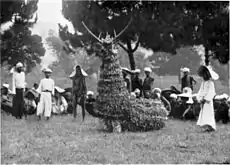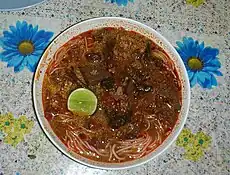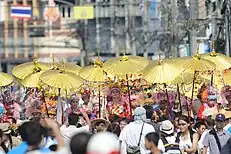Shan people
The Shan people (Shan: တႆး; Shan pronunciation: [táj], Burmese: ရှမ်းလူမျိုး; [ʃán lùmjó]), also known as the Tai Long or Tai Yai, are a Tai ethnic group of Southeast Asia. The Shan are the biggest minority of Burma (Myanmar)[3] and primarily live in the Shan State of this country, but also inhabit parts of Mandalay Region, Kachin State, Kayah State, Sagaing Region and Kayin State, and in adjacent regions of China (Dai people), Laos, Assam and Meghalaya (Ahom people), Cambodia (Kula people), Vietnam and Thailand.[4] Though no reliable census has been taken in Burma since 1935, the Shan are estimated to number 4–6 million,[1] with CIA Factbook giving an estimate of five million spread throughout Myanmar[2] which is about 10% of the overall Burmese population.[3][5]
 National flag of the Shan people | |
 Shan woman from Lai-Hka, Shan State | |
| Total population | |
|---|---|
| c. 5 million (est.)[1][2] | |
| Regions with significant populations | |
(mainly | 5 million[lower-alpha 1][2] |
| Languages | |
| Shan, Burmese, Northern Thai, Thai | |
| Religion | |
| Majority: Theravada Buddhism, Tai folk religion, Minority: Christianity | |
| Related ethnic groups | |
| Tai Ahom, Chinese Shan, Tai people, Tai Lao, Nung Bouyei, Dong, Tai Thai | |

'Shan' is a generic term for all Tai-speaking peoples within Myanmar (Burma). The capital of Shan State is Taunggyi, the fifth-largest city in Myanmar with about 390,000 people. Other major cities include Thibaw (Hsipaw), Lashio, Kengtung and Tachileik.
Etymology
The Shan use the endonym Tai (တႆး) in reference to themselves, which is also used in Chinese (Chinese: 傣族; pinyin: Dǎizú).[6] Shan (ရှမ်း) is an exonym from the Burmese language; the term itself was historically spelt သျှမ်း (MLCTS: hsyam:), and is derived from the term Siam, the former name of Thailand. The term has been borrowed into Chinese (Chinese: 掸族; pinyin: Shànzú). In Thai, the Shan are called Tai Yai (ไทใหญ่, lit. 'Great Tai')[7] or Ngiao (Thai: เงี้ยว) in Tai yuan language. The Shan also have a number of exonyms in other minority languages, including Pa'O: ဖြဝ်ꩻ, Western Pwo Karen: ၥဲၫ့, and Mon သေံဇၞော် (sem).[8]
Subdivisions
Major subdivisions
The major groups of Shan people are:
- Tai Yai (တႆးယႂ်ႇ) or Thai Yai (Thai: ไทใหญ่); the 'Shan Proper', by far the largest group, by which all Shan people are known in the Thai language.
- Tai Lü or Tai Lue (တႆးလိုဝ်ႉ). Its traditional area is in Xishuangbanna (China) and the eastern states.
- Tai Khuen or Tai Khün (တႆးၶိုၼ်), a subgroup of the Tai Yai making up the majority in the Keng Tung area. The former ruling family of Kengtung State belonged to this group.
- Tai Nüa or Tai Neua, (တႆးၼိူဝ်). The 'upper' or 'northern Tai'. This group lives north of the Shweli River, mostly in the area of Dehong, China.
The speakers of Shan, Lue, Khun and Nua languages form the majority of Dai nationality in PRC.
Other Tai Shan groups
There are various ethnic groups designated as Tai throughout Shan State, Sagaing Division and Kachin State. Some of these groups in fact speak Tibeto-Burman and Mon-Khmer and Assamese language, although they are assimilated into Shan society.[9]
- Ahom people: The Ahom people live in India's northeastern state of Assam and Arunachal Pradesh where tradition says that they established the Ahom kingdom, or Mueng Doon Soon Kham, and ruled for almost 600 years (1228-1826). They now speak the Assamese language with the Ahom language falling into disuse by the 19th century.
- Tai Mao, living in the area along the banks of the Shweli River (Nam Mao). Chinese Shan language is also known as (Tai) Mao, referring to the old Shan State of Mong Mao.
- Tai Khamti. The Tai Khamti an outlier group speaking the Khamti language. Traditionally they lived in the northernmost and westernmost edges of Shan-settled areas, such as Putao-O, Kachin State. Part of the Tai Khamti were once ruled by the Mongkawng Shan.
- Tai Laing, Tai Leng, or Shan-ni (lit. 'red Shan'), a Tai group living north of Myitkyina in the Kachin / Shan State border area.[10]
- Tai Ting, a group living around the confluence of the Ting and Salween rivers, just to the west of Gengma County, Yunnan, China.
- Tai Taɯ: Taɯ means 'under' or 'south.' This group lives in southern Shan State.
- Tai Nui, a group living to the south and east of Kengtung town.
- Tai Phake. Related to the Tai Khamti, this group has a significant presence in Assam, India.
- Tai Saʔ. The Tai Saʔ speak a variety of Ngochang (Achang), but are part of mainstream Shan society.
- Tai Loi. The Tai Loi speak a Palaungic language resembling De'ang (especially the Bulei dialect of Yunnan) and Silver Palaung. They take part in mainstream Shan society.
- Tai Dam: Also known as the "Black Tai."
- Tai Dón: Also known as the "White Tai".
- Maingtha, a Shan group that speaks a Northern Burmish language[11]
Culture
The majority of Shan are Theravada Buddhists, and Tai folk religion. The Shan constitute one of the four main Buddhist ethnic groups in Burma; the others are the Bamar, the Mon and the Rakhine. The Mon were the main source of early Shan Buddhism and Shan scripts.[12]
Most Shan speak the Shan language and are bilingual in Burmese. The Shan language, spoken by about 5 or 6 million, is closely related to Thai and Lao, and is part of the family of Tai languages.[13] It is spoken in Shan State, some parts of Kachin State, some parts of Sagaing Division in Burma, parts of Yunnan, and in parts of northwestern Thailand, including Mae Hong Son Province and Chiang Mai Province.[14] The two major dialects differ in number of tones: Hsenwi Shan has six tones, while Mongnai Shan has five.[15] The Shan alphabet is an adaptation of the Mon–Burmese script via the Burmese alphabet.[15]
The Shan are traditionally wet-rice cultivators, shopkeepers, and artisans.[16]
 A Shan deer dance ceremony in the early 1900s |
 Nam ngiao, a Shan dish |
 Shan style pounded oily rice- served on a banana leaf with garlicky roots. Pinlaung, Pinlaung township, Shan State (Pa'O Self Administered Zone) |
History
The Tai-Shan people are believed to have migrated from Yunnan in China. The Shan are descendants of the oldest branch of the Tai-Shan, known as Tai Luang ('Great Tai') or Tai Yai ('Big Tai'). The Tai-Shan who migrated to the south and now inhabit modern-day Laos and Thailand are known as Tai Noi (or Tai Nyai), while those in parts of northern Thailand and Laos are commonly known as Tai Noi ('Little Tai' - Lao spoken)[18] The Shan have inhabited the Shan Plateau and other parts of modern-day Burma as far back as the 10th century CE. The Shan kingdom of Mong Mao (Muang Mao) existed as early as the 10th century CE but became a Burmese vassal state during the reign of King Anawrahta of Pagan (1044–1077).
After the Pagan Kingdom fell to the Mongols in 1287, the Shan chiefs quickly gained power throughout central Burma, and founded:
| State | Peak territory | Duration | Notes |
|---|---|---|---|
| Myinsaing–Pinya Kingdom (1297–1364) | Central Burma | 1297–1364 | Founded by three Shan brothers named Athinkhaya, Yazathingyan and Thihathu, and the minor kingdom was a predecessor to Ava Kingdom |
| Sagaing Kingdom[19] | Central Burma | 1315–1364 | Thihathu was a co-founder of the Myinsaing Kingdom and the founder of the Pinya Kingdom, and the minor kingdom was a predecessor to Ava Kingdom. |
| Confederation of Shan States | Upper Burma | 1527–1555 | A group of Shan States led by Sawlon, Saopha of Mohnyin conquered the Ava Kingdom in 1527 and ruled Upper Burma until 1555 |
| Shan States (Princely states) | Shan States | 1215–1885, 1948–1959 | Princely Shan States |
| British Shan States / Federated Shan States | Shan States | 1885–1922, 1922–1948 | Princely Shan States of British Burma were nominally sovereign princely states, but they were subject to British Crown.[20][21] |
Many Ava and Pegu kings of Burmese history between the 13th-16th centuries were of (partial) Shan descent. The kings of Ava fought kings of Pegu for control of the Irrawaddy valley. Various Shan states fought Ava for the control of Upper Burma. The states of Monyhin (Mong Yang) and Mogaung were the strongest of the Shan States. Monhyin-led Confederation of Shan States defeated Ava in 1527, and ruled all of Upper Burma until 1555.[22]
The Burmese king Bayinnaung conquered all of the Shan states in 1557.[23] Although the Shan states would become a tributary to Irrawaddy valley based Burmese kingdoms from then on, the Shan Saophas retained a large degree of autonomy. Throughout the Burmese feudal era, Shan states supplied much manpower in the service of Burmese kings. Without Shan manpower, it would have been harder for the Burmans alone to achieve their victories in Lower Burma, Siam, and elsewhere. Shans were a major part of Burmese forces in the First Anglo-Burmese War of 1824–1826, and fought valiantly—a fact even the British commanders acknowledged.[24]
In the latter half of the 19th century Shan people migrated into Northern Thailand reaching Phrae Province.[25] The Shan population in Thailand is concentrated mainly in Chiang Rai, Chiang Mai, Mae Hong Son, Mae Sariang, Mae Sai and Lampang, where there are groups which settled long ago and built their own communities and temples. Shan people are known as "Tai Yai" in north Thailand, where the word Shan is very seldom used to refer to them.[26]
After the Third Anglo-Burmese War in 1885, the British gained control of the Shan states. Under the British colonial administration, the Shan principalities were administered separately as British protectorates with limited monarchical powers invested in the Shan Saophas.[27]
After World War II, the Shan and other ethnic minority leaders negotiated with the majority Bamar leadership at the Panglong Conference, and agreed to gain independence from Britain as part of Union of Burma. The Shan states were given the option to secede after 10 years of independence. The Shan states became Shan State in 1948 as part of the newly independent Burma.
General Ne Win's coup d'état overthrew the democratically elected government in 1962, and abolished Shan saopha system.
Shan nationalism
| Shan conflict | ||||||||
|---|---|---|---|---|---|---|---|---|
| Part of internal conflict in Myanmar | ||||||||
| ||||||||
| Belligerents | ||||||||
|
|
MRDA (1985–2000) |
NDA-K (1989–2009) | ||||||
| Commanders and leaders | ||||||||
|
|
|
| ||||||
The Shan have been engaged in an independence struggle that has led to intermittent civil war within Burma for decades. Currently two main Shan armed insurgent forces operate within Shan State: the Shan State Army/Special Region 3 and Shan State Army/Restoration Council of Shan State. In 2005 the Shan State National Army (SSNA) was effectively abolished after its surrender to the Burmese government. Some SSNA units joined the SSA/RCSS, which has yet to sign any agreements, and is still engaged in guerrilla warfare against the Burmese Army.[28]
During conflicts, Shan civilians are often burned out of their villages and forced to flee into Thailand. Some of the worst fighting in recent times occurred in 2002 when the Burmese army shelled the Thai border town of Mae Sai, south of Tachileik, in an attempt to capture members of the SSA's Southern Faction who had fled across the Nam Ruak.[29][30] While in July of that same year, in the Shan Township of Mong Yawng, the killing of a member of an NGO by the Burmese Tatmadaw, and the subsequent closure of the border to Thailand, caused an evacuation of the surviving members across the Mekong River to Laos.[31] This evacuation was aided by members of the Shan State Army, and in turn brought tighter measures restricting foreign aid in the area as violence increased.
Whether or not there is an ongoing conflict, the Shan are subject to depredations by the Burmese regime; in particular, young men may be conscripted into the Burmese Army indefinitely, or enslaved to do road work for a number of months—with no wages and little food. The horrific conditions inside Burma have led to a massive exodus of young Shan males to neighbouring Thailand, where they are not given refugee status. Shan people in Thailand often work as undocumented labourers. Males typically find low-paid work in construction, while many Shan females fall in the hands of human trafficking gangs and end up in the prostitution business or bride trafficking.[32] Despite the hardships, Shan people in Thailand are conscious of their culture and seek occasions to gather in cultural events.[33]
Although the Government of Burma does not recognise Wa State, the Burmese military has frequently used the United Wa State Army (UWSA) as an ally for the purpose of fighting against Shan nationalist militia groups.[34]
Communities in exile

Following the arrest of Sao Shwe Thaik of Yawnghwe in the Burmese coup d'état in March 1962 by the Revolutionary Council headed by General Ne Win,[35] his wife Sao Nang Hearn Kham fled with her family to Thailand in April 1962 and Sao Shwe Thaik died in prison in November the same year. In exile, his wife took up the cause of the independence struggle of the Shan State. In 1964 Sao Nang Hearn Kham with her son Chao-Tzang Yawnghwe helped to form the Shan State War Council (SSWC) and the Shan State Army (SSA), becoming chair of the SSWC,[36] and taking the Shan rebellion that started in 1958 to a new phase.[37] Sao Nang Hearn Kham died on 17 January 2003 in exile in Canada at the age of 86.[36]
Prince Hso Khan Pha (sometimes written as Surkhanfa in Thai), son of Sao Nang Hearn Kham of Yawnghwe lived in exile in Canada. He was campaigning for the Burmese regime to leave the Federated Shan States and return to their own country, to respect the traditional culture and indigenous lands of the Shan people. He worked with the interim Shan Government, with Shan exiles abroad, and the Burmese regime to regain his country.
Opinion has been voiced in the Shan State, in neighboring Thailand, and to some extent in distant exile communities, in favor of the goal of "total independence for the Shan State." This came to a head when, in May 2005, Shan elders in exile declared the independence of the Federated Shan States.
The declaration of independence was rejected by most other ethnic minority groups, many Shan living inside Burma, and the country's leading opposition party, Aung San Suu Kyi's National League for Democracy. Despite the domestic opposition to the declaration, the Burmese Army is rumoured to have used it as a reason to crack down on Shan civilians. Shan people have reported an increase in restrictions on their movements and an escalation in Burmese Army raids on Shan villages. The October 2015 Burmese military offensive in Central Shan State has displaced thousands of Shan people, as well as Palaung, Lisu and Lahu people, causing a new humanitarian crisis.[38][39] Shan civil society organisations are concerned about the lack of international response on the recent conflict.[40]
References
- According to CIA Factbook, the Shan make up 9% of the total population of Myanmar (55 million) or approximately 5 million people.
- "The Shan People". The Peoples of the World Foundation. Archived from the original on 2016-03-14. Retrieved 2015-01-16.
- "The World Factbook — Central Intelligence Agency". cia.gov. Archived from the original on 1 December 2021. Retrieved 24 January 2018.
- "Shan | people". Encyclopedia Britannica. Archived from the original on 2020-10-04. Retrieved 2020-08-26.
- Sao Sāimöng, The Shan States and the British Annexation. Cornell University, Cornell, 1969 (2nd ed.)
- "FACTBOX: The Shan, Myanmar's largest minority". Reuters. 2007-08-30. Archived from the original on 2021-09-29. Retrieved 2020-08-26.
- Sao Tern Moeng (1995). Shan-English Dictionary. Dunwoody Press. ISBN 0-931745-92-6.
- de La Loubère, Simon (1693). "CHAP. II. A Continuation of the Geographical Description of the Kingdom of Siam, with an Account of its Metropolis.". A New Historical Relation of the Kingdom of Siam. Translated by A.P. Archived from the original on 2021-09-24. Retrieved 2021-04-01.
- Shorto, H.L. (1962). Dictionary of Modern Spoken Mon. Oxford University Press.
- Edmondson, Jerold A. 2008. "Shan and other Northern Tier Southeast Tai languages of Myanmar and China: Themes and Variations." In Diller, Anthony, Jerold Edmondson, & Yongxian Luo, (eds.) The Tai–Kadai languages. London: Routledge.
- Pauk, Kyar (24 January 2012). "သွ်မ္းနီလူငယ္: သွ်မ္းနီလူမ်ဳိးတုုိ႔၏ အုုိးစည္ႏုုိင္ငံေတာ္ Country of Drum". ShanniYouth.Blogspot.com. Archived from the original on 24 March 2017. Retrieved 24 March 2017.
- Sawada, Hideo. 2017. Two Undescribed Dialects of Northern Burmish Sub-branch: Gyannoʔ and Thoʔlhang. Presented at ICSTLL 50, Beijing, China.
- Scott, George (1911). "Buddhism in the Shan States". Journal of the Royal Asiatic Society of Great Britain & Ireland. 43 (4): 917–934. doi:10.1017/S0035869X00042295. S2CID 163824875 – via JSTOR.
- Shan language page Archived 2012-09-29 at the Wayback Machine from Ethnologue
- "Shan: A language of Myanmar". Ethnologue. Archived from the original on 2012-09-29. Retrieved 2006-12-02.
- Dalby, Andrew (2004). Dictionary of Languages: The Definitive Reference to More Than 400 Languages. Columbia University Press. ISBN 978-0-231-11569-8.
- Susan Conway, The Shan: Culture, Art and Crafts (Bangkok, 2006).
- "Thai Yai cultural dance at Mae Hong Son, Thailand". ThaiDetails.com. Archived from the original on 29 February 2012. Retrieved 24 March 2017.
- Nisbet, John (2005). Burma under British Rule - and before. Volume 2. Adamant Media Corporation. p. 414. ISBN 978-1-4021-5293-1.
- Lt. Gen. Sir Arthur P. Phayre (1967). History of Burma (2 ed.). London: Susil Gupta. pp. 282–285.
- Great Britain India Office. The Imperial Gazetteer of India. Oxford: Clarendon Press, 1908.
- Census of India 1901 - Burma
- Maung Htin Aung (1967). A History of Burma. New York and London: Cambridge University Press. p. 95.
- Lt. Gen. Sir Arthur P. Phayre (1967). History of Burma (2 ed.). London: Susil Gupta. pp. 108–109.
- Thant Myint-U (2006). The River of Lost Footsteps--Histories of Burma. Farrar, Straus and Giroux. pp. 123–124. ISBN 978-0-374-16342-6.
- "Thailand's World: Shan People Thailand". ThailandsWorld.com. Archived from the original on 22 April 2017. Retrieved 24 March 2017.
- History of Lanna - From Dark Times to Modern Times Archived 2014-01-10 at the Wayback Machine
- Mackerras, Colin (2003). Ethnicity in Asias. Routledge. ISBN 978-0-415-25816-6.
- Photos of Shan State Army-South (SSA-S) military outposts along the border of Thailand, Chiang Rai province Archived 2010-09-23 at the Wayback Machine
- "Mae Sai Evacuated as Shells Hit Town", Bangkok Post, 12 May 2002
- "Mortar Rounds Hit Thai Outpost, 2 Injured", Bangkok Post, 20 June 2002, p.1
- Desmond Ball. Security Developments in the Thailand-Burma Borderlands, Australian Mekong Resource Centre, University of Sydney. October 2003
- Beech, Hannah (2019-08-17). "Teenage Brides Trafficked to China Reveal Ordeal: 'Ma, I've Been Sold'". The New York Times. ISSN 0362-4331. Archived from the original on 2020-08-16. Retrieved 2020-08-28.
- Celebration of Panglong Agreement Day in Loi Tai Leng Archived 2016-02-05 at the Wayback Machine
- "Myanmar: The United Wa State Army's Uncertain Future". ProjectAK47.com. 22 July 2013. Archived from the original on 6 October 2014. Retrieved 24 March 2017.
- Donald M. Seekins (2006). Historical Dictionary of Burma (Myanmar). Rowman & Littlefield. pp. 410–411. ISBN 9780810854765.
- "Burma's first President's wife passed away ( DVB ) January 18, 2003". BurmaToday.net. Archived from the original on 11 September 2014. Retrieved 24 March 2017.
- Smith, Martin (1991). Burma - Insurgency and the Politics of Ethnicity. London and New Jersey: Zed Books.
- PCL., Post Publishing. "Bangkok Post". Archived from the original on 22 October 2023. Retrieved 24 March 2017.
- SHRF. "Naypyidaw must immediately stop its attacks in central Shan State and let communities return home". ShanHumanRights.org. Archived from the original on 28 April 2016. Retrieved 24 March 2017.
- "Shan CSOs blast 'silence' over conflict". Archived from the original on 2015-11-30. Retrieved 2015-12-01.
